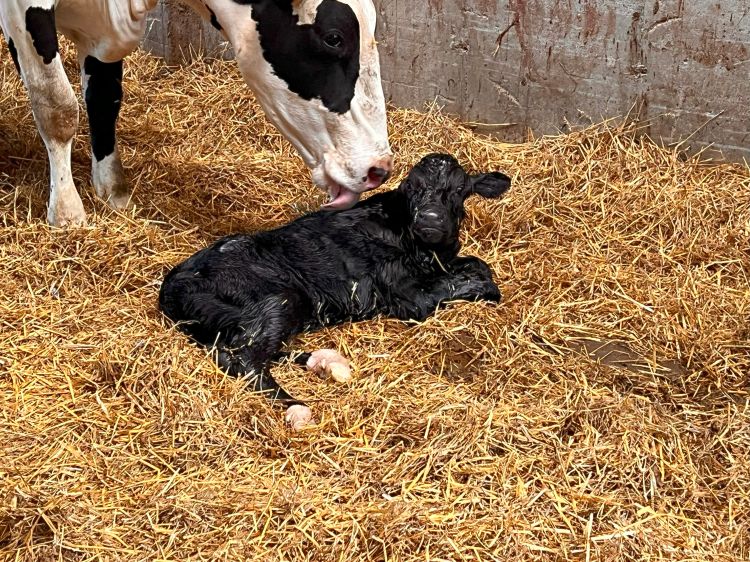Stress management and rumen and hindgut acidosis in dairy calves
Priming young calves through their digestive system can set them up to be super star milk cows or beef cattle.

MSU Extension educator Cora Okkema and Anne Laarman, Ph.D., from the University of Alberta discussed stress management and rumen and hindgut acidosis during a MSU Extension Heifer Academy Webinar.
In his Heifer Academy webinar, “Calf Gut Health and Stress Management,” Laarman walks through the complex but critical connections between early nutrition, stress, and gut development in young calves. While it’s easy to think of colostrum or feed alone as the cornerstone of calf health, Laarman reminds us that the real magic lies in how calves digest, absorb and adapt to their environment—starting on day one.
Why gut health matters early
It’s not just about feed—it’s about what the gut can do with that feed. Both replacement and non-replacement calves (bulls or beef-on-dairy crosses) rely on an efficient, well-developed digestive system to extract energy and nutrients from their diet, support immune development and resist stress. The first 6–8 weeks of life are an especially critical period for development. Research shows that calves with better starter intake during this window see real gains in first-lactation milk production down the line.
But gut development isn’t a straight line, and it doesn’t happen in a vacuum. Calves are transitioning rapidly from a monogastric to a ruminant system, all while facing the stress of weaning, environment, and immune gaps.
Stress, immunity and the gut
Laarman explains that young calves live in a tight immune window. Maternal antibodies from colostrum begin to drop off around 3–4 days of age and calves don’t have enough of their own antibodies until 2–3 weeks old. This leaves a vulnerable gap, where any added stress from weaning, temperature swings or poor nutrition can compromise immunity and gut function. This is where gut health becomes not just a physical issue, but an immunological one. Healthy digestive development begins with microbial seeding and fermentation. Calves suppress immune activity early on to allow “good bugs” to colonize. That same tolerance can open the door to problems if pathogens sneak in.
Meanwhile, starter grain intake kicks off rumen development. But high starch levels can cause low rumen pH, leading to tissue stress in the hindgut, where protection is thinner. Healthy lactating dairy cattle typically range between 6.6-6.0 rumen pH levels. Laarman’s research shows that calves often operate at rumen pH levels (~5.2–5.5). The lower pH levels in calves would equal rumen acidosis in mature cattle. In calves, when fermentation shifts, the hindgut pays the price, highlighting the need for balanced starter grain and controlled weaning transitions. Monitoring outcomes is key so track average daily gain, starter intake and monitor stool consistency. Pair that with strong protocols for feeding, cleanliness and gradual transitions, and you’ll support the calf from the inside out.
The three phases of early-life gut health
Laarman outlines a practical, three-phase approach to managing calf gut health with stress in mind:
Phase 1
The first week of life, where the critical focus in on colostrum intake to boost immunity and jumpstart microbial colonization in the gut.
Phase 2
Weeks two through six. This is where the calf’s immune system is shifting from passive transfer to self-produced antibodies. It is important to provide calves with optimal milk allowance and consistent feeding to facilitate growth and development of all the calf’s systems.
Phase 3
Six weeks. The calf now has active immunity and can be prepared for gradual weaning, once milk and grain consumption have met desirable amounts. This is set by you, your calf team and calf nutrition advisors.
Additional advice to supporting the gut during these phases
Thermal stress
Keep calves warm in cold weather (bedding, jackets, heat sources) and cool in hot weather (shade, airflow, fresh water).
Water access
Calves need fresh, clean water from day one—it supports rumen development and hydration.
Hay feeding
Introduce after 3–4 weeks, but don’t stack it with starter introduction or weaning.
Monitor behavior
Energy dips, loose stools or feed refusal can signal that stress is impacting digestion.

Managing stress well is what transforms gut development from a biological hope into a predictable outcome. Ultimately, Laarman’s insights remind us that supporting calf gut health is about more than nutrition, it is about understanding the delicate balance between nutrition, development, immunity and stress. By recognizing the critical windows of growth and proactively managing factors like diet, environment and transition timing, producers can set calves up for long-term success. This lays the foundation for healthier animals, improved performance, and greater returns in the future. Investing in gut health from day one is truly an investment in the lifetime potential of every future beef animal or milk cow.



 Print
Print Email
Email